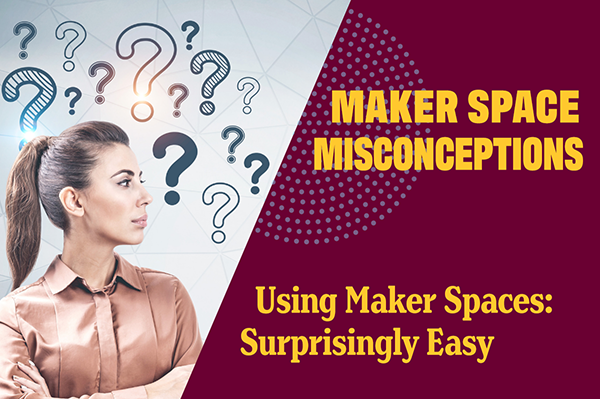From the Office of Curriculum and Instruction Support (CIS), this series will shine new light on our Media Maker Spaces. The next three editions of this newsletter will continue to debunk Maker Space misconceptions, demystify the experience of using our Maker Spaces, and provide suggestions to maximize the impact of your teaching and learning through course media.
Misconception(s): The spaces look intimidating; I feel I won’t be able to figure out how to use them. Maker Spaces are self-serve only, with no hands-on training or real-time help.
In our last issue, we saw the value of incorporating recorded media into your course. This time, we’ll show you how our Maker Spaces were designed, tested, and tailored for your use- regardless of your experience with media or technology!
Yes, you can!
Did you know that the user experience was so important in the development of the Maker Spaces that before opening, each space was thoroughly beta tested by a variety of users? Specifically, beta testers included 24 faculty and staff from 15 different departments across campus (ranging in variables such as age, teaching experience, expertise, confidence with technology, hardware, and software, and more) as well as several children (ages 8 to 16). Feedback from these test users strongly informed the development of instructions and the Maker Space interfaces and helped ready the Maker Spaces for use.
If you’ve ever recorded or watched media on a cell phone (or other mobile devices), then you’re already familiar with most of the equipment and software utilized in each of the Master Spaces. The recent upsurge in virtual meetings and media tools has further prepared us to develop this skillset. President Davies recently encouraged us to capitalize on these new experiences and lessons to continue expanding our virtual teaching and learning skills- precisely in this area!
You don’t have to go it alone!
Each of our spaces is set up so that you can book and record entirely independently. Contactless scheduling and online resources provide on-demand training, and step-by-step directions are provided on-site as well. Of course, CIS Support is always available at each stage of your media production process. Email us to book an appointment with a media expert or teaching and learning consultant; we can help set up, answer questions, and facilitate your use in real-time (appointments are recommended). For more information, be sure to check out our full list of CIS Media Production Resources and Support.
Our Spaces are Tried and True.
Since opening in 2018, more than 150 unique users have successfully reserved and used these Maker Spaces almost 1,000 times to create over 1,800 learning objects for CMU courses. The nearly 60,000 views of these learning objects have contributed to nearly 5,000 hours watched in total. That is a lot of media. Are you ready to make yours?
Don’t take our word for it…
First-time Maker Space users say:
- “[The maker space] was extremely easy to use. I was able to go in and make everything work correctly on my first try… everything just worked without me having to do anything extra.”
- “I learned that the technology is SO MUCH EASIER to use than I ever realized, surprisingly easy- I’d expected it to be a lot harder.”
- “I remember being overwhelmed before my first time using the space, but the video tour and tutorials provided are perfect. I also really appreciate the boards on the side of the teleprompter screen that basically walks you through everything. You just have to follow the instructions, and you’ll be successful! “
Tune in for our next issue to learn how our Maker Spaces can help you make a video that your viewers can’t resist watching.
Resource(s)
Davies, R. (2021) Unexpected silver linings. Central Michigan University, COVID-19: Student Communications. Retrieved from https://www.cmich.edu/covid19/Pages/communications.aspx#collapse37

